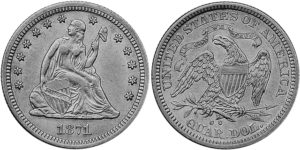 With other denominations, Carson City lives up to its billing as a tough facility. The 1871-CC quarter is typical of a number of coins to emerge from the facility that are tough in any grade and nearly impossible in mint state.
With other denominations, Carson City lives up to its billing as a tough facility. The 1871-CC quarter is typical of a number of coins to emerge from the facility that are tough in any grade and nearly impossible in mint state.
Carson City began producing coins in 1870. It would appear based on mintages that it was a facility not unlike San Francisco had been back when it opened in 1854. The focus initially at Carson City was on upper denominations, like San Francisco. These facilities were located in the middle of staggering discoveries. In the case of San Francisco, it was gold. For Carson City, it was silver.
In the first year of production Carson City produced 8,340 Seated Liberty quarters. That was not surprising as the facility produced no dimes or half dimes but over 50,000 half dollars. The situation reflected priorities as well as what coins were being requested by people bringing in metal. At western mints, upper denominations were more produced than lower denominations.
The quarter production in 1871 at Carson City did not improve much. The total 1871-CC quarter production was put at 10,890 pieces and that explains the $3,450 G-4 price of the 1871-CC today. The 1871-CC is $26,500 in XF-40 and $66,500 in MS-60. However, there are questions about how many examples are available in upper circulated grades or mint state.
The mintage of the 1871-CC alone would make it tough, but 1871 also was not a period of major collecting activity especially in Carson City. We see the same situation repeated at many branch mints when they first opened as they were on the frontier. If a coin got saved it was closer to luck as someone would decide to save a specific coin. There was no pattern of collecting in the area.
We must also remember that collecting nationwide was generally just by date. There were perhaps very few collectors assembling quarter sets by date and mint. It was not easy for a collector in Baltimore to acquire new Carson City issues.
How tough the 1871-CC quarter is can be seen in the fact that NGC has seen only 14 examples with just one, the Eliasberg coin, being called mint state. It is similar at PCGS where just 43 have been graded of which one reached mint state. There is limited demand for the 1871-CC but it is a coin that is really far tougher than prices suggest.
One aspect of its pricing is in order and that is that the 1871-CC gets very tough in upper circulated grades. The price goes from $11,500 in F-12 to $16,000 in VF-20. By the time anyone bothered to find and save an 1871-CC, they had been in regular circulation for some time.
In any grade, the 1871-CC is an extremely tough coin but in light of the numbers known today’s prices make the 1871-CC look like an excellent deal.
This article was originally printed in Numismatic News.
Comments are closed.